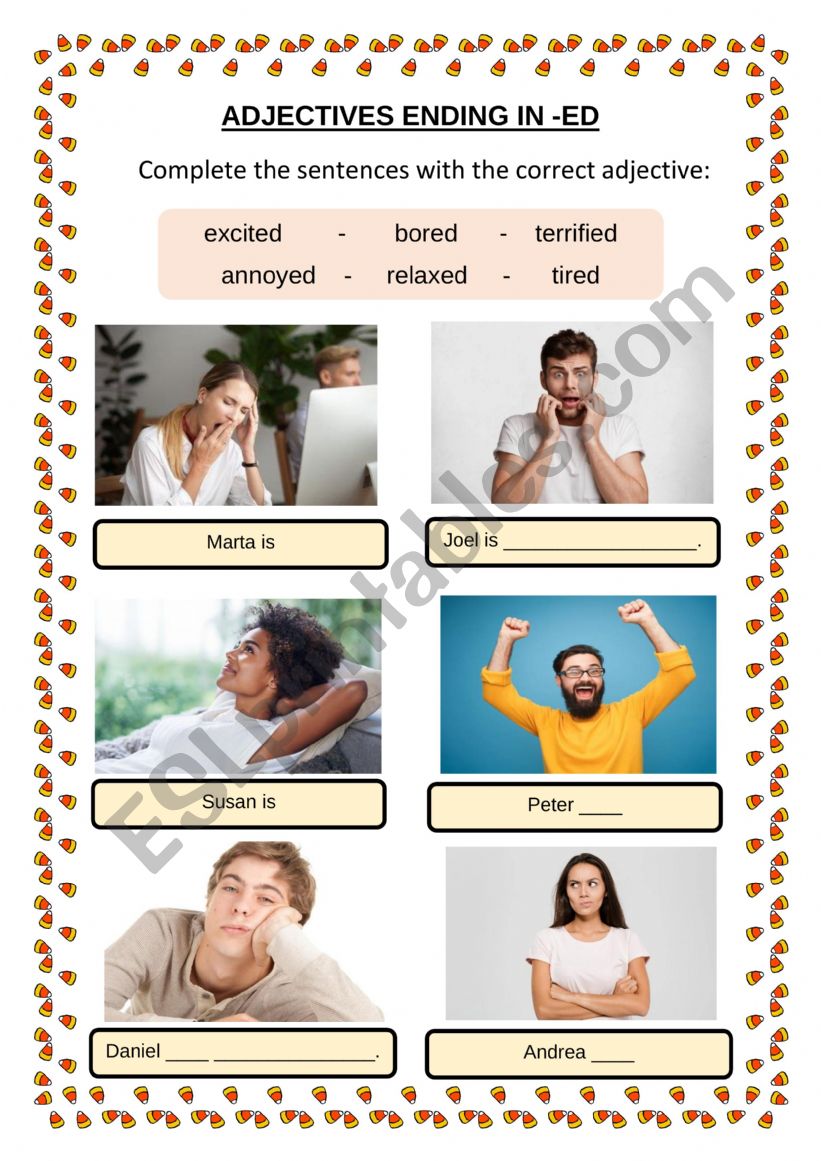
Mastering Emotional Expression: The Power of an Adjectives Ending in -ED Worksheet
The English language, with its vast vocabulary and intricate grammatical structures, can often be a delightful challenge for learners and even native speakers. Among the myriad of linguistic nuances, the correct usage of adjectives that describe feelings and states of being stands out as a particularly common area of confusion. These are the adjectives that often end in -ed, such as "bored," "interested," "confused," or "tired." While seemingly straightforward, their subtle distinction from their -ing counterparts (e.g., "boring," "interesting," "confusing") can lead to miscommunication and a lack of precision in expression. This is precisely where a well-designed adjectives ending in -ed worksheet becomes an invaluable tool for clarification, practice, and ultimately, mastery.
Understanding the Essence of -ED Adjectives

Before diving into the utility of a worksheet, it’s crucial to solidify our understanding of what these adjectives are and how they function. Adjectives ending in -ed are used to describe how a person or an animal feels or the state they are in. They are essentially past participles of verbs that have taken on an adjectival role.

Consider these examples:
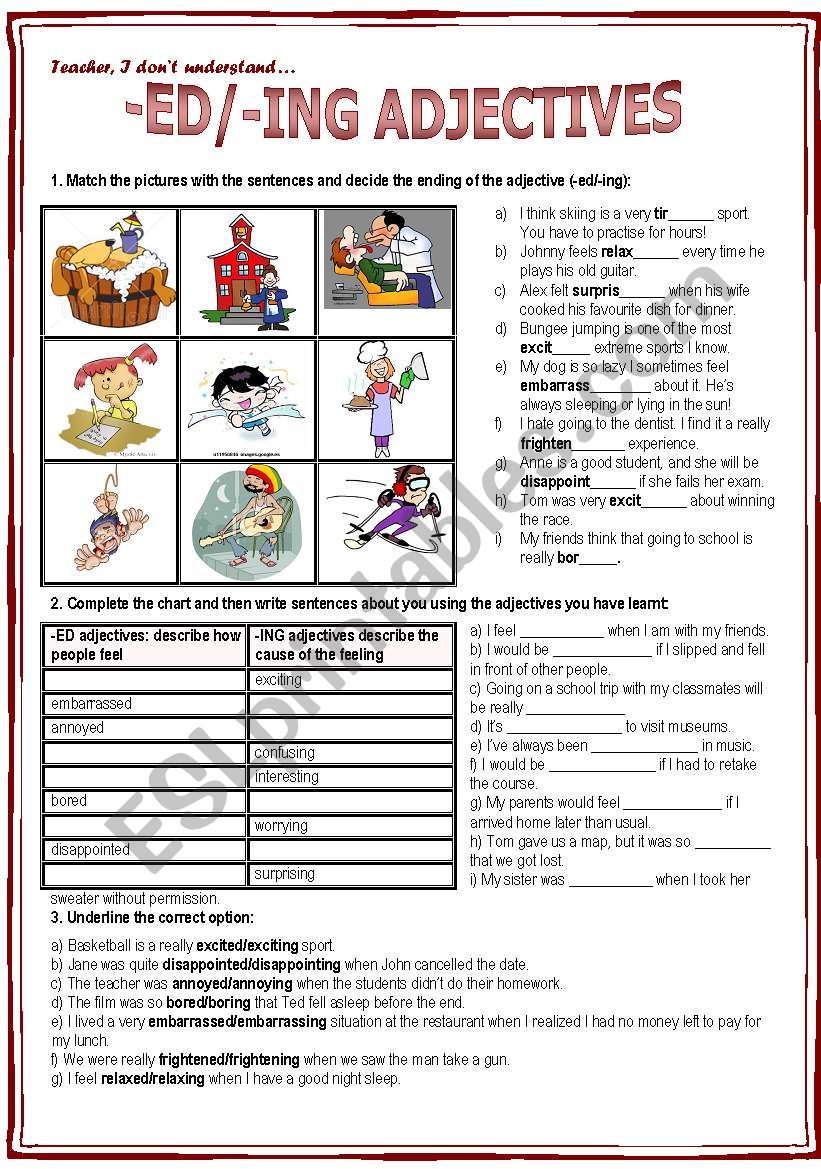
- Bored: I am bored with this lecture. (Describes my feeling)
- Interested: She is very interested in history. (Describes her feeling)
- Confused: The student looked confused by the complex instructions. (Describes the student’s state)
- Excited: We were excited about the upcoming trip. (Describes our feeling)
- Tired: After a long day, he felt incredibly tired. (Describes his state)
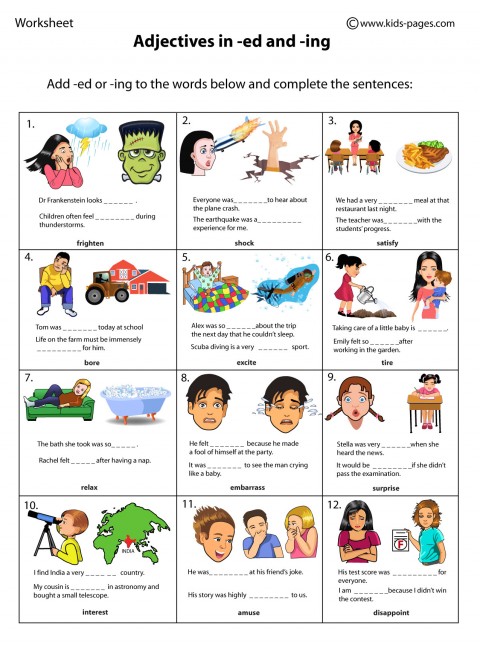


The key takeaway here is that these adjectives are almost always about the receiver of an action or the experiencer of a feeling. They answer the question "How does someone feel?" or "What state is someone in?"
The Common Pitfall: -ED vs. -ING Adjectives
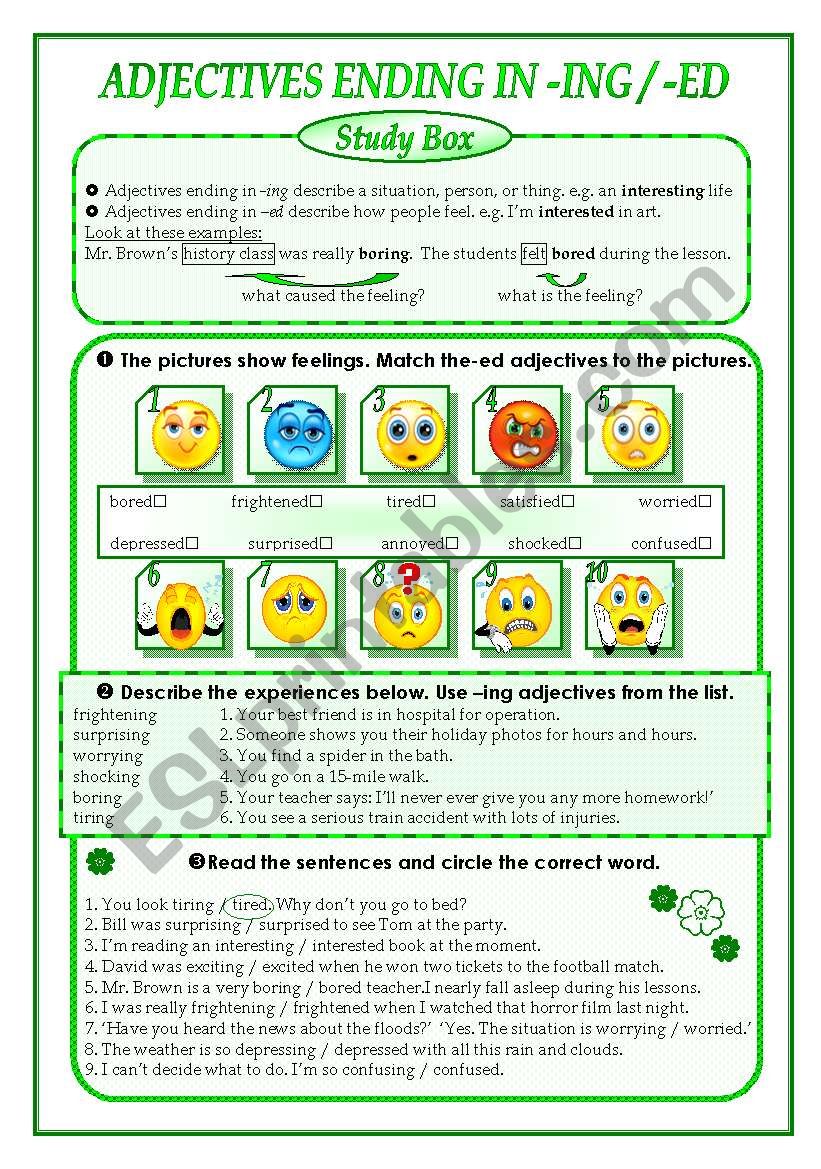
The primary source of confusion arises when distinguishing between adjectives ending in -ed and those ending in -ing. While -ed adjectives describe the feeling or state, -ing adjectives describe the cause of that feeling or state. They describe the thing, person, or situation that produces the feeling.
Let’s look at the same examples with their -ing counterparts:

- Boring: This lecture is boring. (The lecture causes boredom)
- Interesting: History is an interesting subject. (History causes interest)
- Confusing: The instructions were very confusing. (The instructions cause confusion)
- Exciting: The trip will be exciting. (The trip causes excitement)
- Tiring: That long day was very tiring. (The day causes tiredness)
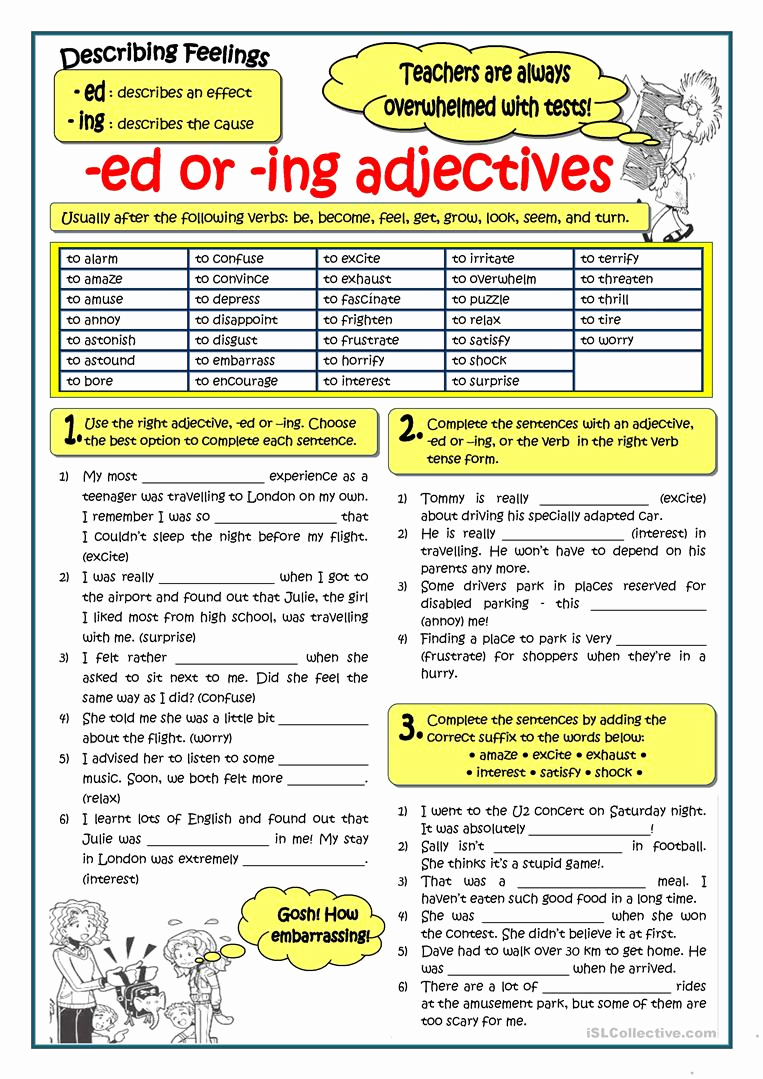
Misusing these can lead to awkward or incorrect sentences. Imagine saying, "I am boring" when you mean "I am bored." The first implies you cause boredom in others, while the second correctly expresses that you feel bored. This stark difference underscores the necessity of targeted practice, which is precisely what an adjectives ending in -ed worksheet aims to provide.
The Indispensable Role of an Adjectives Ending in -ED Worksheet
In the realm of language learning, theory alone often falls short. Practical application and repeated exposure are vital for cementing understanding and developing fluency. This is where a dedicated adjectives ending in -ed worksheet proves its worth.
- Targeted Practice: Worksheets allow learners to focus specifically on the distinction between -ed and -ing adjectives, isolating this particular grammatical point from other complexities. This targeted approach prevents cognitive overload and allows for deeper processing.
- Active Engagement: Unlike passive reading or listening, completing a worksheet requires active participation. Learners must analyze sentences, make choices, and construct their own examples, leading to more robust learning.
- Immediate Feedback (with Answer Keys): A good worksheet often comes with an answer key, enabling learners to check their work instantly. This immediate feedback loop is crucial for identifying errors, understanding the correct usage, and reinforcing accurate patterns.
- Variety of Exercises: Effective worksheets incorporate various exercise types, catering to different learning styles and ensuring comprehensive understanding. From fill-in-the-blanks to sentence creation, this variety keeps the learning process engaging.
- Reinforcement and Repetition: Language acquisition thrives on repetition. Worksheets provide structured opportunities for learners to encounter and use these adjectives multiple times in different contexts, solidifying their understanding over time.
Anatomy of an Effective Adjectives Ending in -ED Worksheet
What makes an adjectives ending in -ed worksheet truly effective? It’s not just about listing words; it’s about designing exercises that promote understanding, critical thinking, and application. Here are key components:
-
Clear Explanations and Examples: Start with a concise review of the rule: -ed for feelings/states, -ing for the cause. Provide clear, contrasting examples before the exercises begin.
- Example: "I was bored because the movie was boring."
-
Fill-in-the-Blanks (Choose -ed or -ing): This is a foundational exercise. Learners are given a sentence with a blank and must choose the correct form of the adjective from a pair.
- Example: The news about the accident was very (shocking/shocked).
- Example: She felt very (depressing/depressed) after failing the exam.
-
Sentence Completion (Create Your Own Sentences): This moves beyond simple recognition to production. Learners are given a noun or a scenario and asked to create sentences using both the -ed and -ing forms.
- Example: "The movie": The movie was . I was .
- Example: "My new job": My new job is . I am about it.
-
Error Correction: Present sentences with incorrect usage of -ed or -ing adjectives and ask learners to identify and correct the errors. This encourages analytical thinking.
- Example: "I am so boring when I have nothing to do." (Correction: bored)
- Example: "The results of the experiment were surprised." (Correction: surprising)
-
Matching Exercises: Match a noun/situation with the appropriate -ing adjective, and then match a person/animal with the appropriate -ed adjective.
- Example: Match: a) difficult test -> confusing; b) confused student -> confused
-
Short Answer/Discussion Prompts: Encourage personalization and deeper application.
- Example: Describe a time you felt very frustrated. What was frustrating about it?
- Example: What kind of movies do you find boring? What makes them boring?
-
Dialogue Completion: Provide a dialogue with blanks where learners must choose the correct -ed or -ing adjective to make the conversation natural.
-
Picture Prompts: Use images that evoke certain feelings or situations. Learners describe the people/animals in the pictures using -ed adjectives and the situation using -ing adjectives.
Designing Your Own Adjectives Ending in -ED Worksheet
For educators or parents, creating a customized worksheet can be highly beneficial. Here are some tips:
- Consider the Learner’s Level: Adjust vocabulary and sentence complexity. For beginners, stick to common adjectives (bored, tired, excited). For advanced learners, introduce more nuanced ones (perplexed, overwhelmed, fascinated).
- Use Relevant Contexts: Incorporate scenarios that are relatable to the learners’ lives, interests, or current curriculum topics. This makes the exercises more meaningful.
- Vary the Difficulty: Include a mix of easy and more challenging questions to keep learners engaged and allow for differentiation.
- Include an Answer Key: This is non-negotiable for self-study and peer-correction.
- Make it Visually Appealing: Use clear fonts, sufficient white space, and perhaps a few relevant images to make the worksheet inviting.
Integrating the Worksheet into Your Lesson Plan
An adjectives ending in -ed worksheet is most effective when integrated thoughtfully into a broader lesson plan:
- Pre-Teaching/Review: Begin by reviewing the core concept of -ed vs. -ing adjectives with clear explanations and examples. Use a whiteboard or projector.
- Guided Practice: Work through the first few exercises of the worksheet together as a class, discussing the reasoning behind each choice.
- Independent Practice: Allow students to complete the rest of the worksheet independently or in pairs. Circulate to offer help and clarification.
- Correction and Discussion: Go over the answers as a class. Encourage students to explain why they chose a particular adjective. This reinforces understanding and addresses misconceptions.
- Follow-up Activities: Extend the learning beyond the worksheet.
- Role-Play: Students use the adjectives in short dialogues.
- Writing Prompts: Ask students to write a short paragraph describing a situation and their feelings about it.
- Games: Play a quick game like "Charades" where one student acts out an -ed feeling, and others guess the adjective.
The Profound Benefits of Mastery
Mastering the correct usage of -ed adjectives, facilitated by consistent practice with a well-structured adjectives ending in -ed worksheet, offers numerous benefits:
- Enhanced Clarity in Communication: Learners can express their feelings and states with precision, avoiding ambiguity.
- Increased Confidence: Correct usage boosts a speaker’s and writer’s confidence, encouraging them to engage more actively in communication.
- Improved Comprehension: Understanding these nuances also aids in better comprehension of written and spoken English, as learners can accurately interpret the emotional tone and states of others.
- Sophisticated Expression: It allows for more nuanced and sophisticated expression, moving beyond basic vocabulary to convey subtle shades of meaning.
- Academic and Professional Success: In academic writing, professional emails, or presentations, precise language is crucial. Mastering these adjectives contributes significantly to overall linguistic competence.
Beyond the Pages: Holistic Learning
While an adjectives ending in -ed worksheet is a powerful tool, it’s part of a larger ecosystem of language learning. To truly internalize these concepts, encourage learners to:
- Read Widely: Pay attention to how authors use -ed and -ing adjectives in context.
- Listen Actively: Notice these adjectives in movies, podcasts, and conversations.
- Speak Regularly: Create opportunities to use these adjectives in real-life conversations.
- Keep a Journal: Encourage personal reflection using these adjectives to describe daily experiences and feelings.
Conclusion
The distinction between adjectives ending in -ed and -ing is a small but significant hurdle in the journey of English language acquisition. It represents a common source of error but also a fantastic opportunity for growth in expressive power. By providing targeted, engaging, and repetitive practice, a thoughtfully designed adjectives ending in -ed worksheet empowers learners to confidently articulate their feelings and describe their experiences with accuracy and nuance. It transforms a potential linguistic pitfall into a stepping stone towards greater fluency and a richer command of the English language. So, whether you are an educator, a student, or a self-learner, embrace the power of this focused practice – your improved communication will be your reward.
